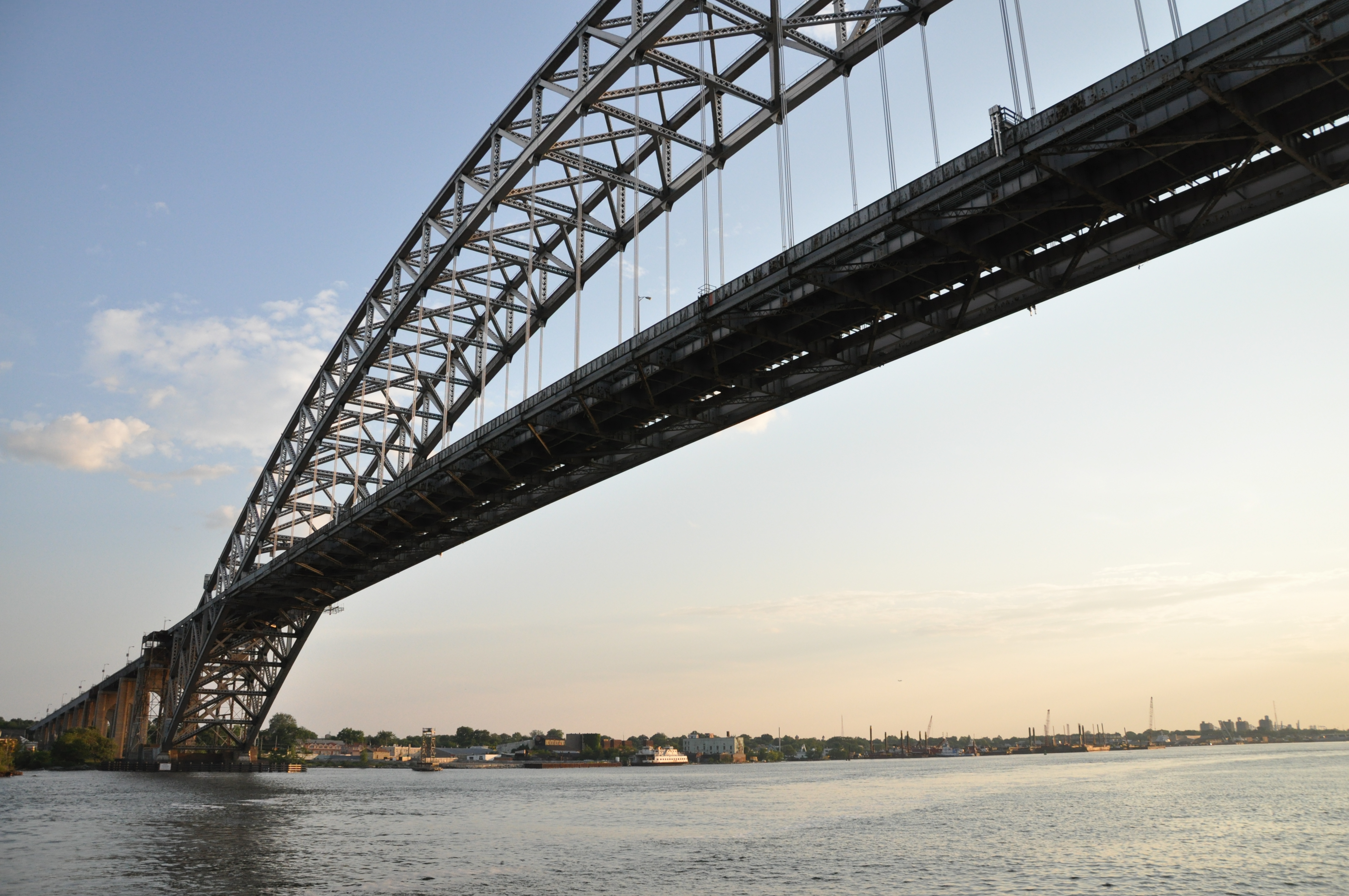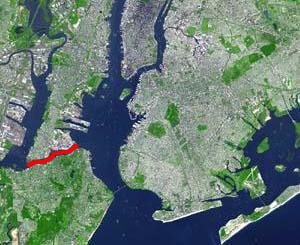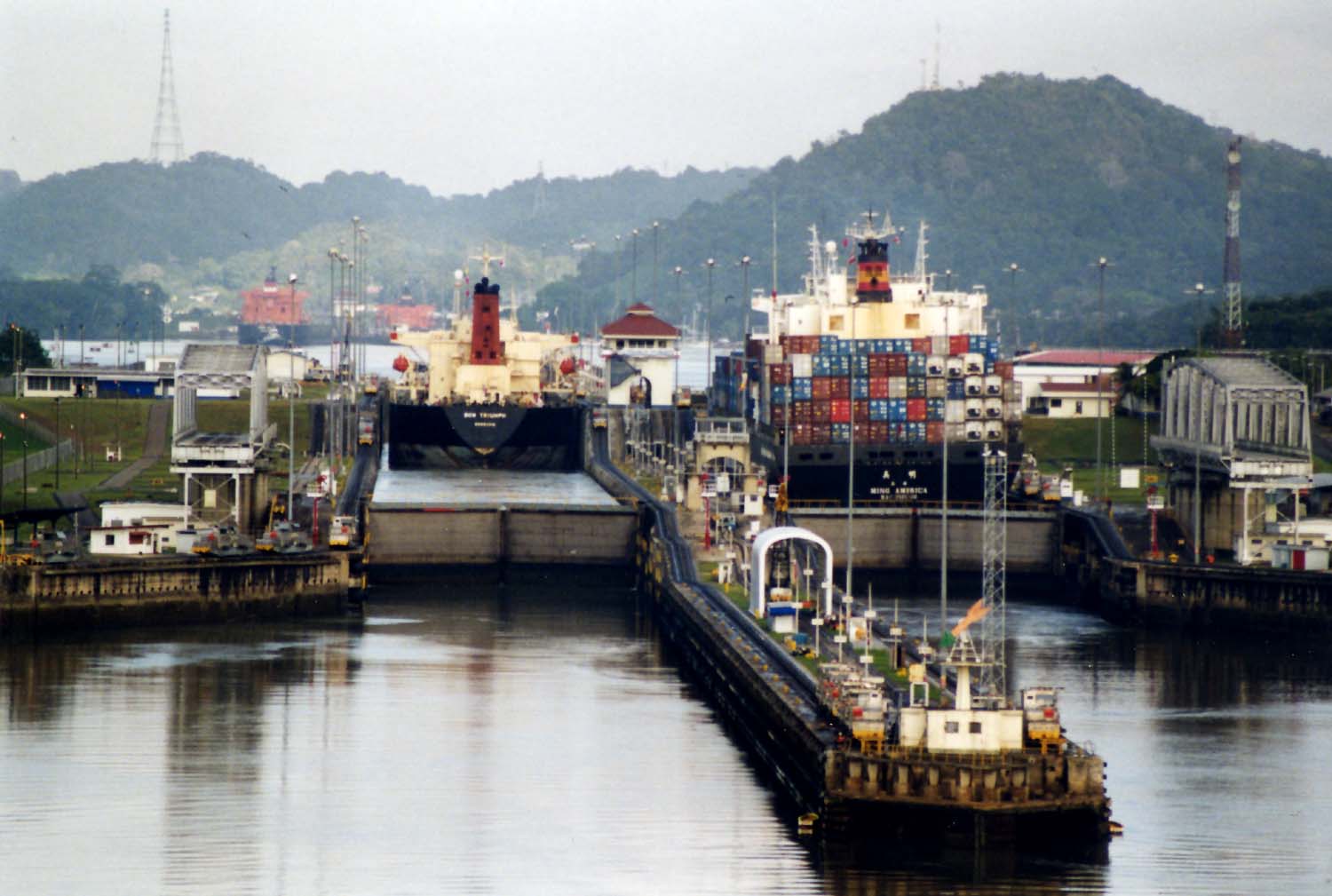|
Bayonne Bridge
Bayonne Bridge is an arch bridge spanning the Kill Van Kull and connecting Bayonne, New Jersey with Staten Island in New York City. It carries New York State Route 440 (NY 440) and New Jersey Route 440. It is the sixth-longest steel arch bridge in the world, and it was the longest in the world at the time of its completion. The bridge is also one of four connecting New Jersey with Staten Island; the other two roadway bridges are the Goethals Bridge in Elizabeth and Outerbridge Crossing (which also carries Route 440) in Perth Amboy, and the rail-only span is the Arthur Kill Vertical Lift Bridge, all of which cross the Arthur Kill. The original roadway carried two lanes of motor traffic in each direction, as well as a walkway. Completed in 1931, the Bayonne Bridge was built by the Port Authority of New York and New Jersey, which still operates the bridge. It was designed by Swiss master bridge-builder Othmar Ammann and architect Cass Gilbert. A project to p ... [...More Info...] [...Related Items...] OR: [Wikipedia] [Google] [Baidu] |
Kill Van Kull
__NOTOC__ The Kill Van Kull is a tidal strait between Staten Island, New York and Bayonne, New Jersey in the United States. It is approximately long and wide and connects Newark Bay with Upper New York Bay. The Robbins Reef Light marks the eastern end of the Kill, Bergen Point its western end. It is spanned by the Bayonne Bridge and is one of the most heavily traveled waterways in the Port of New York and New Jersey. Historically, it has been one of the most important channels for the commerce of the region, providing a passage for marine traffic between Upper New York Bay and the industrial towns of northeastern New Jersey. During the colonial era, it played a significant role in travel between New York and the southern colonies, with passengers changing from ferries to coaches at Elizabethtown (now Elizabeth). Since the final third of the 20th century, it has provided the principal access for oceangoing container ships to Port Newark-Elizabeth Marine Terminal, the bus ... [...More Info...] [...Related Items...] OR: [Wikipedia] [Google] [Baidu] |
Arthur Kill
The Arthur Kill (sometimes referred to as the Staten Island Sound) is a tidal strait between Staten Island (also known as Richmond County), New York and Union and Middlesex counties, New Jersey. It is a major navigational channel of the Port of New York and New Jersey. Etymology The name Arthur Kill is an anglicization of the Dutch language ''achter kill'' meaning ''back channel'', which would refer to its location "behind" Staten Island and has its roots in the early 17th century during the Dutch colonial era when the region was part of New Netherland. Placenaming by early explorers and settlers during the era often referred to a location in reference to other places, its shape, its topography, and other geographic qualities. ''Kill'' comes from the Middle Dutch word ''kille'', meaning ''riverbed'', ''water channel'', or ''stream''. The area around the Newark Bay was called Achter Kol. During the British colonial era the bay was known as ''Cull bay''. The bay lies behind B ... [...More Info...] [...Related Items...] OR: [Wikipedia] [Google] [Baidu] |
Granite
Granite () is a coarse-grained (phaneritic) intrusive igneous rock composed mostly of quartz, alkali feldspar, and plagioclase. It forms from magma with a high content of silica and alkali metal oxides that slowly cools and solidifies underground. It is common in the continental crust of Earth, where it is found in igneous intrusions. These range in size from dikes only a few centimeters across to batholiths exposed over hundreds of square kilometers. Granite is typical of a larger family of ''granitic rocks'', or ''granitoids'', that are composed mostly of coarse-grained quartz and feldspars in varying proportions. These rocks are classified by the relative percentages of quartz, alkali feldspar, and plagioclase (the QAPF classification), with true granite representing granitic rocks rich in quartz and alkali feldspar. Most granitic rocks also contain mica or amphibole minerals, though a few (known as leucogranites) contain almost no dark minerals. Granite is nearly alway ... [...More Info...] [...Related Items...] OR: [Wikipedia] [Google] [Baidu] |
American Heritage Of Invention & Technology
''Invention & Technology Magazine'' (formerly known as ''American Heritage of Invention & Technology'') is a quarterly magazine dedicated to the history of technology. It was launched with sponsorship from General Motors in the summer of 1985 as a spinoff of ''American Heritage'' magazine. Later, the magazine had a partnership with the National Inventors Hall of Fame. “Our subject matter is actually nothing less than the making of the world we live in, and the stories of all the extraordinary people who made it,” wrote Frederick Allen, the Founding Editor, in 1985. He noted that the field of the history of technology is relatively new. "Up to now there has been no general magazine of wide circulation reporting on it. A gap exists between the findings of the scholars and the educated public," he wrote. There were three issues of the magazine a year until 1992, when it became quarterly. Following the Summer 2007 issue (volume 23, number 1), publication was suspended (along with ... [...More Info...] [...Related Items...] OR: [Wikipedia] [Google] [Baidu] |
Gustav Lindenthal
Gustav Lindenthal (May 21, 1850 – July 31, 1935) was a civil engineer who designed the Queensboro and Hell Gate bridges in New York City, among other bridges. Lindenthal's work was greatly affected by his pursuit for perfection and his love of art. Having received little formal education and no degree in civil engineering, Lindenthal based his work on his prior experience and techniques used by other engineers of the time. Early life Lindenthal was born in Brünn, Austrian Empire, now Brno, Czech Republic in 1850. Lindenthal began to receive practical training in 1866 when he was employed as a mason and carpenter. At the age of 18, Lindenthal left his family to set out to make a life of his own in Vienna, Austria. Career When he arrived in Vienna he became an assistant in the engineering department for the Empress Elisabeth Railway of Austria. Two years later he joined the Union Construction Company, where he gained experience in building incline planes and railroads. ... [...More Info...] [...Related Items...] OR: [Wikipedia] [Google] [Baidu] |
Hell Gate Bridge
The Hell Gate Bridge, originally the New York Connecting Railroad Bridge or the East River Arch Bridge, is a steel through arch railroad bridge in New York City. Originally built for four tracks, the bridge currently carries two tracks of Amtrak's Northeast Corridor and one freight track across the Hell Gate, a strait of the East River, between Astoria in Queens and Randalls and Wards Islands in Manhattan. The arch across the Hell Gate is the largest of three bridges that form the Hell Gate railroad viaduct. An inverted bowstring truss bridge with four spans crosses the Little Hell Gate, a former strait that is now filled in, and a fixed truss bridge crosses the Bronx Kill, a strait now narrowed by fill. Together with approaches, the bridges are more than long. The designs of the Tyne Bridge in Newcastle, England and the Sydney Harbour Bridge in New South Wales, Australia were derived from the Hell Gate Bridge. History The bridge was conceived in the early 1900s to link ... [...More Info...] [...Related Items...] OR: [Wikipedia] [Google] [Baidu] |
Parabolic Arch
A parabolic arch is an arch in the shape of a parabola.Article about parabolic arch by The Free DictionaryParabolic arch , Article about parabolic arch by The Free Dictionary accessdate: March 2, 2017 In structures, their curve represents an efficient method of load, and so can be found in bridges and in architecture in a variety of forms. Description The mathematics While a parabolic arch may resemble a catenary arch, a parabola is a quadratic function while a catenary is the hyperbolic cosine, , a sum of two exponential functions. One parabola is , and hyperbolic cosine is . The curves are unrelated. The line of thrust Unlike a catenary arch, the parabolic arch employs the principle that when weight is uniformly applied above, the internal compression (see line of thrust) resulting from that weight will follow a parabolic curve. Of all arch types, the parabolic arch produces the most thrust at the base. Also, it can span the widest area. It is commonly used in bridge design, ... [...More Info...] [...Related Items...] OR: [Wikipedia] [Google] [Baidu] |
Post-Panamax
Panamax and New Panamax (or Neopanamax) are terms for the size limits for ships travelling through the Panama Canal. The limits and requirements are published by the Panama Canal Authority (ACP) in a publication titled "Vessel Requirements". These requirements also describe topics like exceptional dry seasonal limits, propulsion, communications, and detailed ship design. The allowable size is limited by the width and length of the available lock chambers, by the depth of water in the canal, and by the height of the Bridge of the Americas since that bridge's construction. These dimensions give clear parameters for ships destined to traverse the Panama Canal and have influenced the design of cargo ships, naval vessels, and passenger ships. Panamax specifications have been in effect since the opening of the canal in 1914. In 2009, the ACP published the New Panamax specification which came into effect when the canal's third set of locks, larger than the original two, opened on ... [...More Info...] [...Related Items...] OR: [Wikipedia] [Google] [Baidu] |
United States Navy
The United States Navy (USN) is the maritime service branch of the United States Armed Forces and one of the eight uniformed services of the United States. It is the largest and most powerful navy in the world, with the estimated tonnage of its active battle fleet alone exceeding the next 13 navies combined, including 11 allies or partner nations of the United States as of 2015. It has the highest combined battle fleet tonnage (4,635,628 tonnes as of 2019) and the world's largest aircraft carrier fleet, with eleven in service, two new carriers under construction, and five other carriers planned. With 336,978 personnel on active duty and 101,583 in the Ready Reserve, the United States Navy is the third largest of the United States military service branches in terms of personnel. It has 290 deployable combat vessels and more than 2,623 operational aircraft . The United States Navy traces its origins to the Continental Navy, which was established during the American Revo ... [...More Info...] [...Related Items...] OR: [Wikipedia] [Google] [Baidu] |
Pier (architecture)
A pier, in architecture, is an upright support for a structure or superstructure such as an arch or bridge. Sections of structural walls between openings (bays) can function as piers. External or free-standing walls may have piers at the ends or on corners. Description The simplest cross section of the pier is square, or rectangular, but other shapes are also common. In medieval architecture, massive circular supports called drum piers, cruciform (cross-shaped) piers, and compound piers are common architectural elements. Columns are a similar upright support, but stand on a round base. In buildings with a sequence of bays between piers, each opening (window or door) between two piers is considered a single bay. Bridge piers Single-span bridges have abutments at each end that support the weight of the bridge and serve as retaining walls to resist lateral movement of the earthen fill of the bridge approach. Multi-span bridges require piers to support the ends of spans betwe ... [...More Info...] [...Related Items...] OR: [Wikipedia] [Google] [Baidu] |
Hudson County, New Jersey
Hudson County is the most densely populated county in the U.S. state of New Jersey. It lies west of the lower Hudson River, which was named for Henry Hudson, the sea captain who explored the area in 1609. Part of New Jersey's Gateway Region in the New York metropolitan area, the county's county seat and largest city is Jersey City,New Jersey County Map New Jersey Department of State. Accessed July 10, 2017. whose population as of the was 292,449. As of the |
Port Richmond, Staten Island
Port Richmond is a neighborhood situated on the North Shore of Staten Island, a borough of New York City. Port Richmond is bounded by Kill van Kull on the north, Jewett Avenue on the east, Forest Avenue on the south, and the Bayonne Bridge on the west. It is adjacent to West New Brighton to the east, Westerleigh to the south, and Elm Park and Mariners Harbor to the west. Formerly an independent village, it is one of the oldest neighborhoods on the island. In the 19th century it was an important transportation and industrial center of the island, but this role has vanished nearly completely, leaving a largely blue collar residential area bypassed by the shift of development of the island to its interior after the 1960s. The formerly bustling commercial center along Richmond Avenue (now Port Richmond Avenue) had been largely abandoned at the time, but many small businesses have opened in the area since the late 20th century. Port Richmond is part of Staten Island Community Dist ... [...More Info...] [...Related Items...] OR: [Wikipedia] [Google] [Baidu] |











